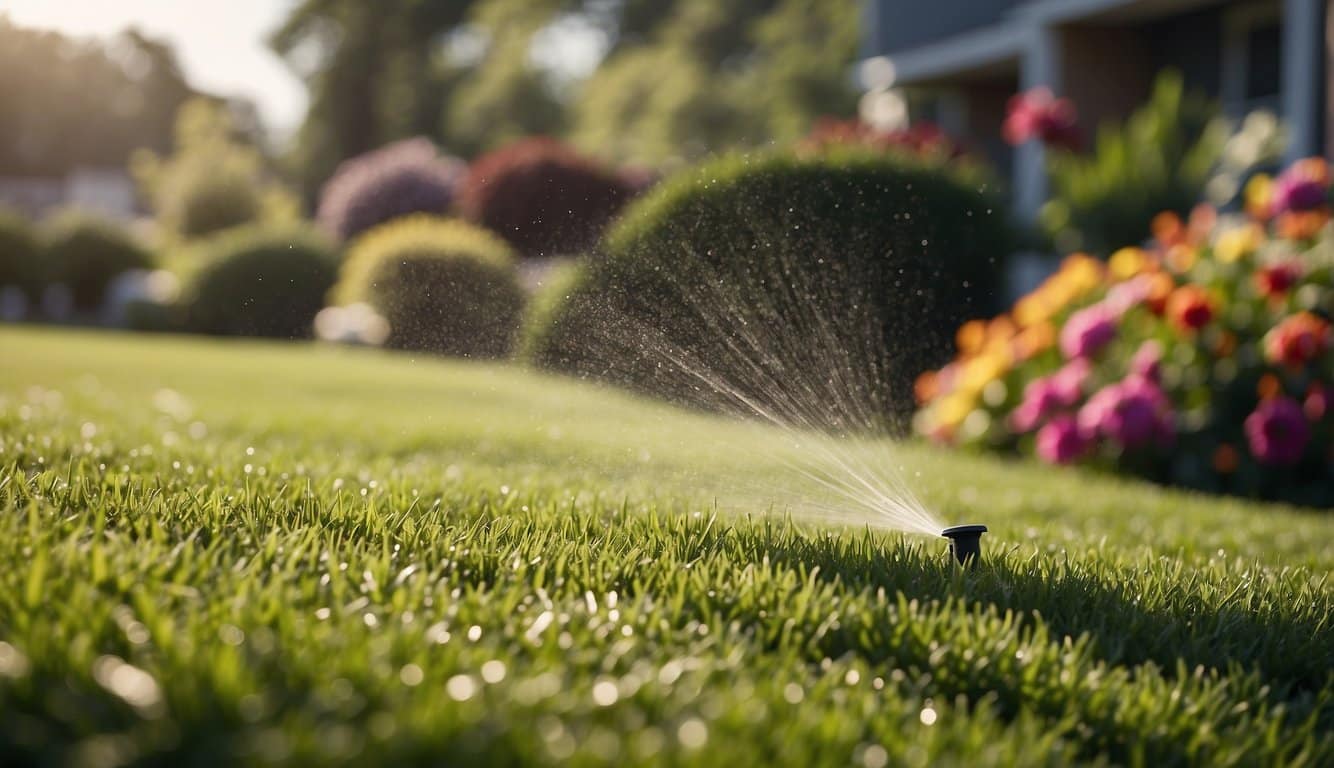Understanding Missouri’s Climate and Soil
Missouri lawns flourish by acknowledging the state’s unique climate and soil conditions. Homeowners benefit greatly from understanding these elements to maintain a healthy turfgrass.
Regional Climate Variations
Missouri’s climate is classified as humid continental in the north and humid subtropical in the south, with a blend of both in a transitional zone in between. This duality presents unique challenges for turfgrass due to variations in temperature and humidity.
The state experiences distinct seasonal changes, with cold winters and hot, often humid, summers. These temperature fluctuations impact the type of turfgrass that can thrive in different regions.
- Northern Missouri: Cooler temperatures; requires cool-season grasses.
- Southern Missouri: Warmer temperatures; suitable for warm-season grasses.
- Transitional Zone: Both cool and warm-season grasses can be considered.
Soil Types and Testing
The soil across Missouri generally ranges from slightly acidic to neutral, with the optimal pH for turfgrass being between 6.0 to 7.0.
Various soil types, from clay-heavy to sandy loams, can be found throughout the state, influencing water retention and nutrient availability.
- pH Testing: Essential for determining soil acidity and identifying amendments needed.
- Nutrient Availability: Best within the 6.0 to 7.0 pH range.
- Soil Composition: Varies across regions, impacting grass selection and maintenance practices.
Homeowners should conduct soil tests regularly to manage fertilization effectively and adjust soil pH levels, if necessary, for optimum turfgrass health and growth.
Selecting the Right Turfgrass Species
When embarking on establishing a vibrant lawn in Missouri, the choice of turfgrass species is crucial due to the state’s wide-ranging climate.
They should opt for grass types well-suited to Missouri’s temperatures, considering whether a cool-season, warm-season, or shade-tolerant variety aligns best with their lawn’s specific conditions.
Cool-Season Grasses
Cool-season grasses thrive in Missouri’s fall and spring, exhibiting growth spurts in cooler temperatures.
- Kentucky Bluegrass: Known for its fine texture and lush green color, Kentucky Bluegrass is widely used in Missouri for its ability to form a dense lawn. It requires more maintenance in terms of mowing and watering.
- Tall Fescue: This species is valued for its drought tolerance and ability to adapt to various soil types. Tall Fescue is less maintenance-intensive and has decent shade tolerance.
Warm-Season Grasses
Warm-season grasses have their growth peak in the heat of summer.
- Zoysia: Highly resistant to heat and drought, Zoysia forms a dense carpet-like turf but can turn brown during cool seasons.
- Bermudagrass: It is prized for its durability and fine texture but can be invasive and requires full sun exposure.
Shade-Tolerant Varieties
Some turfgrasses can prosper even with limited sunlight.
- Fine Fescue: Offering a fine-bladed appearance, fine fescues are more shade-tolerant than most grasses and require less maintenance.
- Supina Bluegrass: This grass has excellent shade tolerance and can maintain a green color in lower light conditions.
Lawn Installation and Establishment

Proper lawn installation and establishment are critical for the long-term health and appearance of turfgrass in Missouri. Timing, method, and preparation greatly influence success in creating lush, resilient lawns.
Seeding Techniques
Timing: The optimal window for seeding cool-season grasses in Missouri is between August 25 and October 10. This period gives the seeds enough time to germinate and establish before winter.
- Soil Preparation: Before sowing the seed, the land must be cleared of debris and the soil loosened.
- Soil Testing: A 4-inch soil sample should be obtained using a soil probe or small trowel to send for nutrient and pH analysis.
- Seed Distribution: Seeds should be evenly spread using a broadcaster or drop spreader to ensure even coverage.
- Seedbed Preparation: Seedbeds should be lightly raked and then rolled or compacted to ensure seed-to-soil contact.
Sodding Best Practices
Preparation: Sod requires similar soil preparation as seeding. The ground must be leveled and enriched based on soil test recommendations.
- Lay sod on moist soil, staggering the joints in a brick-like pattern to avoid continuous seams.
- Watering: Sod should be watered thoroughly after installation and for the following weeks until roots are established.
Hydroseeding Fundamentals
Mixture: Hydroseeding involves spraying a slurry containing seed, mulch, fertilizer, and water onto prepared soil.
- Application: Uniform application is crucial for an even lawn without bare spots.
- Erosion Control: The mulch in the slurry helps protect against erosion while the grass is establishing.
- Care: Post-application care includes keeping the area moist to facilitate germination and watching for weeds during establishment.
Cultural Practices for Turf Health
Maintaining a healthy lawn in Missouri involves a blend of proper mowing, watering, fertilization, and soil management practices. Implementing these strategies efficiently combats turfgrass diseases and promotes a robust and vibrant lawn.
Mowing Guidelines
Optimal Mowing Height: It is crucial to cut turfgrass at the species-specific recommended height. For instance, Kentucky bluegrass and tall fescue thrive when mown to a height of 3-4 inches.
Mowing Frequency: Mow regularly enough to remove no more than one-third of the leaf blade’s height at a time. This approach encourages root growth and reduces stress on the grass.
Watering Essentials
Irrigation Timing: Early morning watering is ideal as it allows moisture to reach the roots before evaporation and minimizes prolonged leaf wetness that can lead to disease.
Watering Depth: Deep, infrequent watering that moistens the soil to a depth of 4-6 inches encourages deep root systems. Typically, this translates to about 1 to 1.5 inches of water per week.
Fertilization Strategies
Soil Testing: Before fertilization, perform a soil test to determine the specific nutrient needs of your lawn.
Fertilizer Application: Apply fertilizers based on the lawn’s growth cycle and the results of the soil test. Avoid over-fertilizing to reduce the risk of turfgrass diseases.
Aeration and Dethatching
Core Aeration: Aerating the lawn helps alleviate soil compaction, allowing roots to expand, and improves water and nutrient uptake. Perform aeration during the turf’s peak growth period.
Thatch Management: When thatch exceeds half an inch, it can restrict water and nutrient flow. Dethatching removes this layer, promoting a healthier turf environment.
Integrated Turfgrass Pest Management
Integrated Pest Management (IPM) is a strategic approach that combines various management tactics for maintaining healthy turfgrass while minimizing pesticide use. Effective IPM requires identification of pests, understanding their lifecycles, and implementing targeted control methods.
Common Lawn Pests
Missouri’s turfgrass ecosystems are susceptible to a variety of pests, including grubs, chinch bugs, and sod webworms.
Grubs, the larvae of beetles, feed on roots, causing the turf to wilt and brown. Meanwhile, Chinch bugs suck juices from grass blades, inducing stress, while sod webworms chew on foliage, leading to irregular brown patches.
Disease Prevention
Prevention of turfgrass diseases begins with selecting the right grass species for the environment.
Grasses less susceptible to pathogens, such as tall fescue which is resistant to summer patch disease, can greatly reduce disease presence. Applying the right amount and type of fertilizer promotes healthy, vigorous turfgrass, which is naturally more resistant to diseases.
Weed Control Options
Comprehensive weed control in an IPM strategy involves both pre-emergent and post-emergent solutions.
Pre-emergent herbicides prevent weed seeds from germinating, whereas post-emergent herbicides address existing weeds.
It is crucial for homeowners to identify weeds accurately to choose proper control methods.
Eco-Friendly Pest Solutions
Biological controls such as beneficial nematodes can be applied to combat grubs, being both effective and environmentally responsible.
Pesticides should be used as a last resort, and Missouri residents can consult the Extension Plant Nematology Laboratory for guidance.
When chemical interventions are necessary, they should be selected and applied according to law and with consideration for pollinators and non-target species.
Frequently Asked Questions
This section addresses common inquiries Missouri residents have about lawn care.
It provides month-by-month guidance, maintenance practices for warm-season lawns, the use of organic care techniques, understanding the growth temperatures for turfgrass, optimal timing for lawn aeration and overseeding, and fertilization frequency for sustained lawn health.
What is the month-by-month lawn care calendar for Missouri?
In Missouri, lawn care begins in March with pre-emergent herbicide applications and mowing as required.
April involves broadleaf weed control and assessing soil moisture.
May is the time for fertilizing cool-season grasses.
During the summer months, focus shifts to watering and managing heat stress.
September is ideal for seeding and aeration, October for fertilizing, and November for the last mowing.
Winter months are generally for rest and planning.
What is the recommended maintenance practice for warm-season lawns?
For warm-season lawns in Missouri, maintenance includes regular mowing to the recommended height for the specific grass species, proper irrigation without overwatering, and fertilizing during the active growth period.
Homeowners should dethatch and aerate as necessary, usually once every one or two years, to maintain soil structure and nutrient flow.
What are the organic turf care cultural practices to maintain a healthy lawn?
Organic turf care cultural practices involve using compost to improve soil structure, choosing appropriate grass species for the local environment, and implementing correct mowing techniques.
Additionally, homeowners should encourage natural predators to control pests and limit the use of chemicals to maintain a healthy lawn ecosystem.
What is the optimal temperature range for warm-season turfgrasses?
Warm-season turfgrasses thrive at temperatures between 80°F to 95°F.
These grasses grow best in the warmth of late spring to early fall and typically enter a dormant state during the cooler months.
When is the best time to aerate and overseed lawns in Missouri?
Aeration and overseeding for cool-season grasses in Missouri is best done in early fall, often from late August to October.
This period provides optimal soil temperatures and moisture levels that promote seed germination and root development before the onset of winter.
How often should you fertilize your lawn in Missouri for optimal health?
Fertilization frequency for Missouri lawns should align with the growth cycle of the turfgrass used.
Cool-season grasses benefit from fertilization in spring and fall, whereas warm-season grasses should be fertilized during their peak growth in the late spring and summer months.
A soil test can help to tailor the fertilization schedule based on nutrient needs.
Last update on 2025-04-26 / Affiliate links / Images from Amazon Product Advertising API






